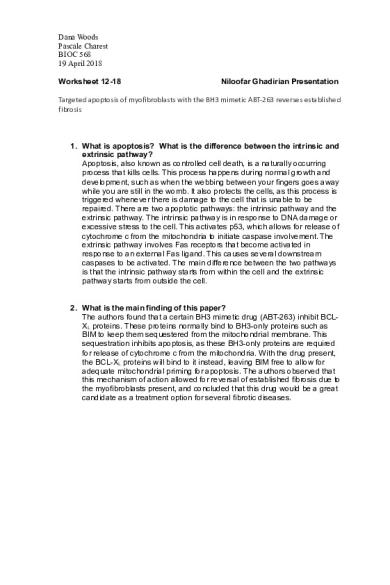Worksheet 12-18 - The professor\'s name was Pascale Charest. PDF

| Title | Worksheet 12-18 - The professor\'s name was Pascale Charest. |
|---|---|
| Course | Nucleic Acids, Metabolism, and Signaling |
| Institution | University of Arizona |
| Pages | 1 |
| File Size | 80.3 KB |
| File Type | |
| Total Downloads | 76 |
| Total Views | 138 |
Summary
The professor's name was Pascale Charest....
Description
Dana Woods Pascale Charest BIOC 568 19 April 2018 Worksheet 12-18
Niloofar Ghadirian Presentation
Targeted apoptosis of myofibroblasts with the BH3 mimetic ABT-263 reverses established fibrosis
1. What is apoptosis? What is the difference between the intrinsic and extrinsic pathway? Apoptosis, also known as controlled cell death, is a naturally occurring process that kills cells. This process happens during normal growth and development, such as when the webbing between your fingers goes away while you are still in the womb. It also protects the cells, as this process is triggered whenever there is damage to the cell that is unable to be repaired. There are two apoptotic pathways: the intrinsic pathway and the extrinsic pathway. The intrinsic pathway is in response to DNA damage or excessive stress to the cell. This activates p53, which allows for release of cytochrome c from the mitochondria to initiate caspase involvement. The extrinsic pathway involves Fas receptors that become activated in response to an external Fas ligand. This causes several downstream caspases to be activated. The main difference between the two pathways is that the intrinsic pathway starts from within the cell and the extrinsic pathway starts from outside the cell. 2. What is the main finding of this paper? The authors found that a certain BH3 mimetic drug (ABT-263) inhibit BCLXL proteins. These proteins normally bind to BH3-only proteins such as BIM to keep them sequestered from the mitochondrial membrane. This sequestration inhibits apoptosis, as these BH3-only proteins are required for release of cytochrome c from the mitochondria. With the drug present, the BCL-XL proteins will bind to it instead, leaving BIM free to allow for adequate mitochondrial priming for apoptosis. The authors observed that this mechanism of action allowed for reversal of established fibrosis due to the myofibroblasts present, and concluded that this drug would be a great candidate as a treatment option for several fibrotic diseases....
Similar Free PDFs

Jenkins Fifi Was My Mother\'s Name
- 26 Pages

De pascale 1 - Apuntes
- 34 Pages

Quiz 9: FIN4324 RVC 1218
- 9 Pages

Quiz 6: FIN4324 RVC 1218
- 10 Pages
Popular Institutions
- Tinajero National High School - Annex
- Politeknik Caltex Riau
- Yokohama City University
- SGT University
- University of Al-Qadisiyah
- Divine Word College of Vigan
- Techniek College Rotterdam
- Universidade de Santiago
- Universiti Teknologi MARA Cawangan Johor Kampus Pasir Gudang
- Poltekkes Kemenkes Yogyakarta
- Baguio City National High School
- Colegio san marcos
- preparatoria uno
- Centro de Bachillerato Tecnológico Industrial y de Servicios No. 107
- Dalian Maritime University
- Quang Trung Secondary School
- Colegio Tecnológico en Informática
- Corporación Regional de Educación Superior
- Grupo CEDVA
- Dar Al Uloom University
- Centro de Estudios Preuniversitarios de la Universidad Nacional de Ingeniería
- 上智大学
- Aakash International School, Nuna Majara
- San Felipe Neri Catholic School
- Kang Chiao International School - New Taipei City
- Misamis Occidental National High School
- Institución Educativa Escuela Normal Juan Ladrilleros
- Kolehiyo ng Pantukan
- Batanes State College
- Instituto Continental
- Sekolah Menengah Kejuruan Kesehatan Kaltara (Tarakan)
- Colegio de La Inmaculada Concepcion - Cebu











